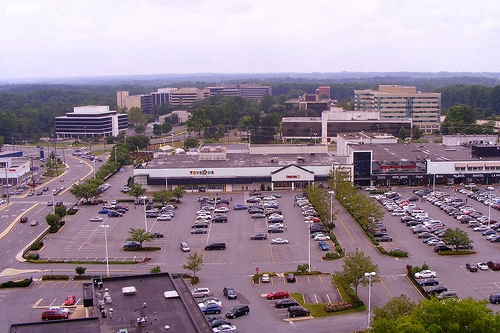Montgomery parking requirements looser, but not enough
Montgomery County’s new zoning code will allow less parking in new developments in order to use land more efficiently and encourage alternatives to driving. However, the regulations still require parking in ways that will hinder the walkable urban places the county wants to build.
For four years, the Planning Department has been revising its complicated, unwieldy zoning code. First written in 1928, the code hasn’t been updated since 1977, when the county was still mostly suburban. The new code will go before the County Council in a public hearing June 11.
Under the current code, buildings must have lots of parking, even near transit or in areas where most people don’t drive. The new parking regulations are simpler and allow developers to build fewer parking spaces, though they do require other amenities, like bike racks, changing facilities and spaces for car sharing or carpools.
New rules require less parking, more amenities
The new code reduces parking requirements throughout the county, especially in its parking benefit districts where public parking is available, like Silver Spring, Bethesda, Wheaton, Montgomery Hills and eventually White Flint.
Restaurants currently must have 25 parking spaces per 1000 square feet, a little smaller than a Chipotle. Under the new rules, a restaurant would only need between 4 and 10 spaces, depending on whether it was in a parking district. Meanwhile, office buildings outside a parking district will only need 2.25 spaces per 1000 square feet, compared to 3 today.
Some rules have been simplified. The current law requires different amounts of parking for different kinds of stores; for instance, a “country market” must provide 5 parking spaces for each 1000 square feet, while a furniture store needs only 2. Under the new code, all stores would be required to have 3.5 spaces per 1000 square feet in parking districts, and 5 spaces elsewhere.
New buildings would also have to accommodate alternate modes of transportation by providing bike parking. Larger buildings will have to include space for car sharing, while developers would be able to swap out car parking spaces for carpool spaces, bikeshare stations or changing facilities.
However, the parking requirements for housing won’t change much. Single-family homes and townhomes would still need 2 off-street parking spaces or 1 if they’re in a parking district, same as before, while new apartments would need at least 1 parking space, regardless of where they are. However, apartment developers could build less parking if they “unbundle” them, meaning that residents could buy or rent a space separately from their unit.
Do we still need parking requirements?
While the new requirements are an improvement, some local groups argue that there shouldn’t be parking requirements at all. The Coalition for Smarter Growth, the Montgomery County Sierra Club, and the Action Committee for Transit, where I sit on the board, have all come out against parking minimums.
Why? For starters, parking is expensive to build and rarely pays for itself. Construction costs for a space in a parking lot are about $3,500, compared to $30,000 for one in a garage and $100,000 for one underground, not counting the cost of land. Parking fees rarely cover these expenses alone, so the costs get passed on to the public in other ways, like higher prices at a restaurant that’s charged higher rents by its landlord.
Meanwhile, our communities pay for a glut of parking. Surface parking lots that are only full on Black Friday take up valuable space that could be used for buildings or parks instead. And even attractively designed parking garages like this one in Rockville still create a dead space, hurting street life. On top of that, parking lots produce a lot of stormwater runoff, polluting waterways.
This isn’t to say that we shouldn’t have any parking, but the costs of excess parking outweigh the benefits. As Matt Yglesias writes in Slate, people will continue to want parking, and any developer who wants to stay in business will satisfy them without being told to:
Almost 100 percent of Washington-area residents like to sleep on a soft comforable surface at night. But there’s no regulatory requirement that residential buildings contain mattresses. The lack of mattress mandates doesn’t mean people are forced to sleep on the floor. It means that if people want to sleep on a mattress—and they generally do—they need to go buy one.
Once you take away the Agricultural Reserve, residential neighborhoods, and other uses, you’re left with about 4% of Montgomery County that’s available for development. That land is valuable, and we need to use it well. Covering it with big parking lots isn’t the right solution, but that’s what our current zoning code requires. While the new law’s a step in the right direction, it may not go far enough to create the kind of places we want.
The County Council will hold a public hearing on the Zoning Rewrite on Tuesday, June 11 at 7:30pm. To sign up to testify or submit written comments, visit their website.


